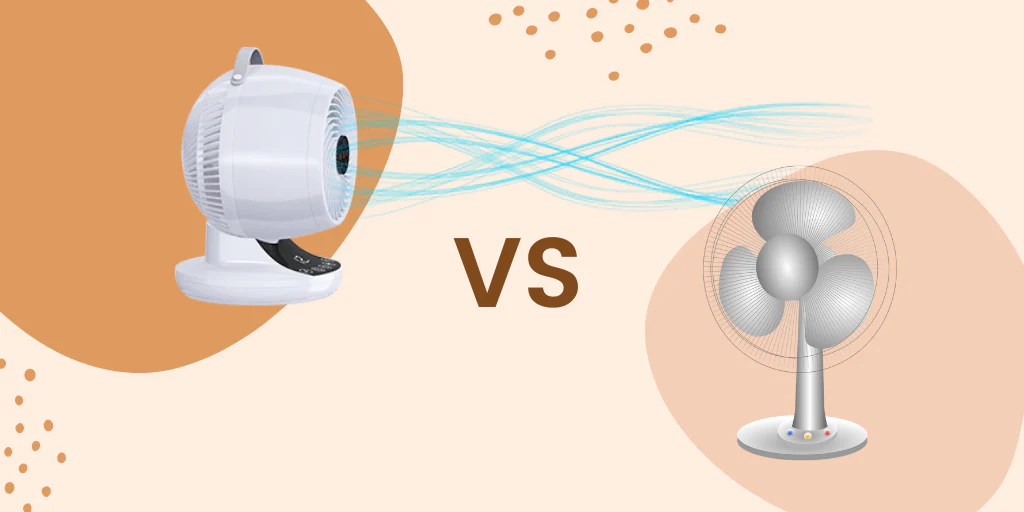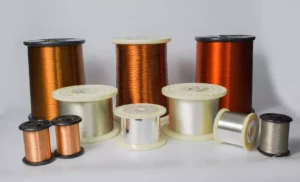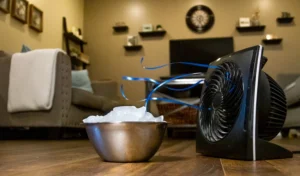Feeling hot in a stuffy room?
A regular fan just pushes hot air around.
There is a better way to cool your entire space.
An air circulator moves all the air in a room to create an even, comfortable temperature.
A traditional fan simply blows air in one direction for personal cooling.
Both help you feel cooler, but they work in very different ways.
So, you might be wondering which one is the right choice for your home.
They can look very similar, but their functions are not the same.
Let’s break down how each one works and help you decide which is the best fit for your needs.
How Do Traditional Fans Work?
Your room feels hot and stuffy.
You turn on a fan, but you only feel cool when it’s pointed right at you.
This direct cooling is limiting.
A traditional fan works by creating a direct stream of air.
This airflow helps you feel cooler by speeding up the evaporation of sweat on your skin.
It does not actually lower the room’s temperature.
A fan is a simple machine.
It has blades that spin to push air forward.
This action creates a wind-like effect.
You feel this breeze on your skin, and it provides a cooling sensation.
This process is known as evaporative cooling.
It’s a very effective way to get personal relief from the heat.
However, the key limitation is that you must be in the direct path of the airflow to feel its benefits.
If you move out of the fan’s stream, you’ll immediately notice the cooling effect is gone.
The Science of Feeling Cooler
Fans don’t actually make the air colder.
The temperature in the room remains the same.
The cooling feeling comes entirely from the interaction between the moving air and your skin.
Here’s a simple breakdown:
- Air Movement: The fan’s blades slice through the air, creating a focused current.
- Evaporation: Your body naturally produces sweat to cool down. When air moves across your skin, it helps this sweat evaporate much faster.
- Heat Removal: The process of evaporation requires energy, which it takes from your body in the form of heat. This is what makes you feel cooler.
Because of this mechanism, a fan’s effectiveness is limited.
It creates what is essentially a “cool zone” right in front of it.
This is why many fans have an oscillation feature.
The fan head moves from side to side to spread this cool zone over a wider area.
But even with oscillation, it’s still just providing temporary, direct relief to specific spots in a room.
It is not designed to create a consistent temperature throughout the entire space.
Types of Traditional Fans
There are several common types of fans, but they all operate on the same basic principle of direct airflow.
- Pedestal Fans: These are the classic stand-up fans. They are adjustable in height and usually oscillate to cover a larger area.
- Tower Fans: These are tall and slim. They blow air out of a vertical column. They often have a smaller footprint and can be more stylish, but they provide the same kind of direct cooling.
- Desk Fans: These are small, personal fans meant to be placed on a desk or table to cool one person.
- Box Fans: These are simple, square fans that can move a lot of air but are often noisy and less directional.
All these fans share one thing: they are for personal cooling.
They are not built to circulate air throughout a whole room.
How Do Air Circulators Work?
Your fan is on, but the room still has hot spots.
The air feels stagnant and uncomfortable.
An air circulator solves this by moving all the air.
Air circulators use a special technology to create a powerful, focused beam of air.
This beam bounces off walls and ceilings.
This process keeps all the air in the room constantly moving for whole-room comfort.
An air circulator is much more than just a fan.
Its design is based on aerodynamics to achieve a very specific goal: whole-room air circulation.
It doesn’t just blow air forward; it creates a continuous current of air that flows throughout the entire space.
This eliminates the hot and cold spots that traditional fans can’t touch.
The feeling is less like a direct wind and more like a gentle, constant breeze that fills the room.
The “Vortex” Effect
The secret to an air circulator’s power is its ability to create what is often called a “vortex” or an “invisible jet stream.”
Here’s how it works:
- Air Intake: The unit pulls air in from the back.
- Focused Column: It then funnels this air through a deep, pitched set of blades and a tight spiral grill. This action shapes the air into a tight, powerful column. This column of air is very different from the wide, turbulent cone of air that a fan produces.
- Long-Range Projection: Because the air is so focused, it can travel much farther across a room without losing power. It can easily reach the opposite wall.
This focused beam of air is the engine that drives the whole-room circulation.
Bouncing Air for Full Circulation
Once the column of air hits a wall, it doesn’t just stop.
It bounces and continues to move.
The ideal way to use an air circulator is to aim it towards a wall, about halfway between the floor and the ceiling.
The air travels across the room and hits the wall.
It then moves up towards the ceiling.
From the ceiling, it flows across the room again.
It then travels down the opposite wall.
Finally, it moves across the floor and back towards the air circulator.
This creates a complete, circular flow that gets all the air in the room moving.
This continuous motion mixes the air, evening out the temperature and making the entire room feel more comfortable.
It also helps with ventilation by mixing stale air with fresh air from an open window.
Many powerful air circulators don’t even need to oscillate because this vortex action does all the work.
Key Differences: Airflow and Coverage
A fan feels good but only cools a small spot.
You want to cool the whole room, not just one chair.
The difference is in the airflow.
A fan provides direct, personal cooling in a focused stream.
An air circulator creates a continuous, room-wide airflow pattern.
This means a circulator offers even comfort throughout the entire space, not just in one spot.
The single biggest distinction between a fan and an air circulator is how they move air.
This fundamental difference affects everything from how they cool you down to where you should place them in a room.
Understanding this is key to choosing the right product for your home.
While both use blades to move air, the way they shape and direct that air leads to completely different outcomes.
One is built for a quick, personal breeze, while the other is engineered for consistent, whole-room comfort.
Direct vs. Indirect Cooling
A traditional fan offers direct cooling.
It needs to be pointed at you to work.
The sensation of coolness it provides is immediate and strong, but it is also geographically limited.
As soon as you step out of its path, the feeling is gone.
This makes it a tool for personal comfort.
An air circulator, on the other hand, offers indirect cooling.
You don’t need to be in its direct path to feel its effects.
By keeping the air in the entire room in constant motion, it creates a more uniform and comfortable environment.
It gets rid of the stuffy, stagnant feeling and eliminates pockets of warm air.
The goal is not to create a powerful blast of wind but to make the entire room a more pleasant place to be.
Room Coverage and Placement
The different airflow patterns also dictate where you should place the device.
- Fan Placement: A fan must be positioned so its airflow can reach you directly. This often means placing it in the middle of a room or on a nearby table, where it can become an obstacle.
- Air Circulator Placement: An air circulator is more flexible. Because it works by bouncing air off surfaces, you can place it out of the way in a corner. As long as it can create its circulation pattern, it will cool the room effectively.
Here is a simple table to summarize the core differences:
| Feature | Traditional Fan | Air Circulator |
| Airflow Pattern | Direct, focused stream (cone-shaped) | Whole-room, vortex action (column-shaped) |
| Cooling Method | Personal cooling (evaporation) | Room-wide temperature balance |
| Best For | Cooling one or two people directly | Making a large space feel comfortable |
| Placement | Must be aimed at the user | Can be placed in a corner, aimed at a wall |
When Should You Choose an Air Circulator?
You have an air conditioner, but some rooms stay warm.
Or you have a large living room that never feels evenly cool.
An air circulator is the solution.
An air circulator is the best choice when you need to cool a large, entire space evenly.
It is especially effective when used with an AC unit, as it helps distribute the cold air much more efficiently.
An air circulator is a versatile tool that shines in specific situations where a traditional fan would struggle.
It’s an investment in overall room comfort rather than just personal cooling.
If you find yourself dealing with uneven temperatures, stuffy rooms, or want to get more out of your existing heating and cooling systems, an air circulator is likely the right choice for you.
It is a year-round appliance that can improve the comfort of your home in any season.
You Have an Air Conditioner
This is where an air circulator truly excels.
An air conditioner produces cold air, but it often has trouble distributing that air evenly throughout a room.
This can lead to a situation where it’s freezing next to the AC unit but still warm on the other side of the room.
An air circulator solves this problem perfectly.
By creating whole-room circulation, it picks up the cool air from the AC and distributes it quickly and evenly to every corner.
This has two major benefits:
- Improved Comfort: The entire room cools down faster and more consistently.
- Energy Savings: Your AC unit won’t have to work as hard to reach the desired temperature, which can save you money on your electricity bills. You can think of the air circulator as a “turbo boost” for your air conditioner.
You Need to Cool a Large Area
If you’re trying to make a large living room, open-plan kitchen, or master bedroom more comfortable, a traditional fan won’t be enough.
It can only cool the people directly in its path.
An air circulator, however, is designed specifically for this kind of challenge.
Its powerful airflow can move the air in a large space, ensuring that no area is left feeling hot and stagnant.
You Want Year-Round Use
A fan is mostly a summer appliance.
But an air circulator is useful all year long.
In the winter, you can use it with your heater.
Hot air naturally rises, which means a lot of the warmth from your heater gets trapped near the ceiling where it does no good.
By pointing an air circulator upwards on a low setting, you can push that trapped warm air back down and circulate it throughout the room.
This results in a more even temperature and can make your heating system more efficient, again saving you money.
It also helps with general room ventilation in spring and autumn.
When is a Traditional Fan a Better Choice?
You need a quick, direct breeze to cool you down right now.
Or you’re sitting outside on a hot day.
In these cases, a simple fan is best.
A traditional fan is the better choice for immediate, personal cooling.
It’s also the only option that works effectively outdoors, as an air circulator needs enclosed spaces to create its airflow pattern.
While air circulators offer many advantages, there are still situations where a good old-fashioned fan is the more practical and effective option.
A fan’s simplicity and directness are its greatest strengths.
If your goal is straightforward and personal, a fan is often all you need.
It’s a reliable tool for getting a quick blast of cooling air exactly where you want it.
It’s important to match the tool to the task, and sometimes, the simplest tool is the right one.
You Need Personal Cooling
If your primary goal is to cool just yourself, a fan is perfect.
Imagine you’re working at your desk or watching TV on the couch.
A fan can provide a direct, refreshing breeze right where you need it.
You don’t need to cool the entire room, just your personal space.
In this scenario, the whole-room circulation of an air circulator would be unnecessary.
A fan is more efficient for this specific task.
You’re Using it Outdoors
An air circulator relies on walls and ceilings to bounce its airflow and create a circulation pattern.
Outside, on a patio or in a garden, there are no walls.
This means an air circulator’s main feature is useless outdoors.
A traditional fan, however, works perfectly outside.
It can generate a cooling breeze to make sitting on your porch on a hot day much more pleasant.
Some fans, known as misting fans, are even specifically designed for outdoor use and can be especially effective.
You Don’t Have Air Conditioning
If you don’t have an AC unit, an air circulator’s ability to amplify a cool air source is less relevant.
While it can still help by circulating air from an open window, a traditional fan might feel more effective on its own.
The strong, direct airflow of a fan can provide a more powerful sensation of cooling through evaporation, which can be more satisfying on a hot day when there is no other source of cold air.
That said, many air circulators can also be used like a fan by simply pointing them directly at you.
Conclusion
Fans provide direct, personal cooling.
Air circulators move all the air for whole-room comfort.
Your choice depends on whether you need to cool a person or a space.
Frequently Asked Questions (FAQ)
1. Can you use an air circulator as a regular fan?
Yes, you can usually point an air circulator directly at you for personal cooling.
However, it is primarily designed for whole-room circulation for maximum efficiency.
2. Do air circulators use a lot of electricity?
No, they are generally very energy-efficient, especially models with modern DC motors.
They can also help your AC work less, which saves even more energy.
3. Where is the best place to put an air circulator?
For best results, place it against a wall or in a corner.
Aim it towards the opposite wall, about halfway up, to establish the circulation pattern.
4. Is an air circulator quieter than a fan?
Often, yes.
Many air circulators are engineered for whisper-quiet operation, making them a better choice for bedrooms and quiet offices than many traditional fans.
5. Can an air circulator cool a room without AC?
It cannot lower the air temperature.
However, it makes you feel cooler by moving the air and can efficiently circulate cooler air from an open window throughout the room.
6. Are air circulators good for winter?
Yes.
In winter, they are excellent for distributing warm air from your heater, which naturally rises, down to the living space for a more evenly heated room.







